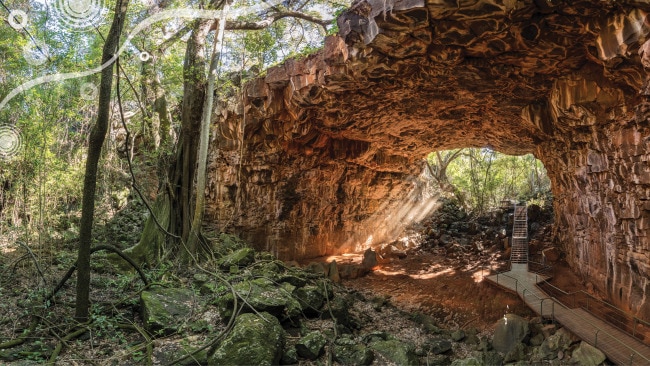Why taking photos won’t take you out of the moment
They get to travel the world capturing some of the world’s most extraordinary places. Four professional photographers share their favourite images.

They get to travel the world capturing some of the world’s most extraordinary places. Four Canon photographers share their favourite images, and how they manage to stay in the moment.
In the age of image abundance, do we cherish the photos we take? There are the sunsets, the selfies, cute pets, intricate restaurant dishes and weekends away. When we capture these moments, do we ever look at them again? And when life is full of so many incredible moments, do we stop to really appreciate them? Should we disconnect from technology, or should we try to capture those moments, so we have them forever?
We asked some of Australia’s great photographers, part of the Canon Collective, to share the shot they want to preserve for at least 100 years — and tell us what photography means to them.
JENNIFER COOPER, SYDNEY
It was a trip to Antarctica that Jennifer Cooper will always remember.
“There was this extraordinary moment where a few penguins were singing the most remarkable song. It was just like Happy Feet come to life,” she says. “I was able to creep up on my tummy with the camera, and, even though I was really close to them, they continued to sing really loudly. Taking that photo from a really low perspective enabled me to really capture those penguins who were singing and dancing.”
Cooper has this particular image printed and hanging on her wall at home.
“These days, people have their mobile phone in their pocket at all times and can snap a million pictures a day. There’s nothing wrong with that, but it’s not the photos on my phone that are hanging on my wall,” she says. “The photos that I am actually really proud of and that have stories behind them, are the ones I’ve taken on my camera.”
It has taken discipline and maturity developed over her years as a professional photographer to rein in her enthusiasm to capture every place she visits and people she meets.
“When I was much younger, I would go on holiday and take a thousand photos,” Cooper says. “But nowadays I can appreciate a magical moment, but I don’t need to whip my camera out and capture everything.”
It’s only when she stumbles across “a scene where the light is perfect, the framing is right, the subject is perfect, and I’ve got the right lens” that she takes the time to immortalise the moment.
“I already know in my mind this is going to be an image I’m going to print and hang on my wall,” she says.
Cooper says digital images are too easily lost in the abyss of the online cloud (“do you ever actually look back over them?” or lost on corrupted hard drives — there’s something “magical” about holding an image in your hands — “it has such a different feeling”.
“If you print your photos out, they last one hundred years with the Pixma Pro printer,” she says. “I’m often reminded of some of my best times when I’m home and look around at my walls, which is nice. Although you can’t hear the penguins singing, I’ll always remember how they sounded when I look at that picture.”
TIP: CHECK OUT CAMERA ASSIST
“If you want to learn more about a specific camera model you own, Canon has created some beneficial video tutorials called Camera Assist. It’s a little more model-driven, so you watch one of the Canon Collective Ambassadors walking you through how that camera operates. They’ll share a few helpful tips and tricks to help you get the most out of your camera.”
NEAL WALTERS, MELBOURNE
Neal Walters lives the enviable life running events and tutorials for beginner and experienced photographers in his role as a Canon Collective Ambassador and also travelling the world capturing the things he loves most: primarily music, fashion and culture.
But it’s a landscape image taken from the heights of a hot air balloon floating over Byron Bay he’s most proud of.
“We had it up at sunrise over Byron, floating over this little lake. Just as the sun was peeking up over the horizon, it was perfectly still on the water with a single tree in the middle. The golden light came over and hit the cloud and reflected onto the lake. It actually looked like the lake was in the clouds,” he says. “As I was taking it I couldn't believe what I was seeing. One of those magical moments.”
TIP: GET OFF AUTO MODE
“On auto mode, your camera makes all of the decisions to you. I would encourage people to get to know the manual functions of their camera so that they feel they have more artistic merit to the photos they’re taking,” Walters says.
He says progressing from auto mode is a bit like learning to drive a manual car — “You need to know all those little first steps” before driving solo.
“At Canon Collective we teach people the basics of what their camera can do, which involves using TV mode, which stands for ‘time value’. And AV mode, which is ‘aperture value’. Those two modes are where you can utilise shutter speed and aperture to add a little bit of your own creative spin onto your photos and give your photography a much-needed boost. Once you understand those settings a little bit better, it is a lot easier to get. And once you start seeing results, I think you use your camera more and more.”
Walters says newer cameras — like the Canon EOS 200D Mark II — come with an in-built guided display designed to teach the user how to operate their camera as they shoot.
“On the back of the screen it tells you what will happen to your shot if you turn your shutter to the left, so your camera is giving you a lot more help when people like myself aren’t around.”
JAY COLLIER, MELBOURNE
He has taken over 300,000 images capturing African wildlife over his 15 years, but it’s this image of a herd of elephants at a private game reserve in Botswana that Jay Collier is most proud of.
“I was co-hosting a photographic safari alongside my good friends Shem Compion and Denis Glennon,” he says. “It was a quiet morning in July which can be very cold, so nothing much was happening as the wildlife was sheltering.”
The group waited at the watering hole for over three hours, not even a bird broke the stillness. Overcome by boredom and tiredness, Collier says he dozed off.
“Before I knew it, I was surrounded by at least 50 to 60 elephants,” he says, recalling being woken up by elephants so close he could almost reach out and touch them. “I felt as if I had taken a shot of adrenaline directly to the heart as more appeared in mass numbers, billowing dust, trumpeting with excitement at the sign of water.”
Collier says elephants were usually “ridiculously difficult to photograph” as their bodies were usually blown out or lost in shadow when captured against the typical harsh light of a bright blue day.
“But on that day, I was lucky enough to have perfect conditions with the overcast sky,” he says. “Shooting with a EOS 1D X Mark II and EF 16-35mm f/2.8L II USM Lens I shot this image at 16mm with the camera on the ground. Within one meter of where I was positioned was a baby elephant which was suckling from its mother at the time. I had to pay attention to the edges of my frame and look for a balance, as well as also ensure the camera didn’t get stepped on or covered in mud.”
TIP: BECOME ‘ADDICTED’ TO LIGHT
“Quite often moving a small amount changes the way light falls on your subject or background,” Collier advises. “I often say ‘small movements make massive differences’ when comparing an image. The light on your subject and backgrounds can make or break an image and too often photographers who are starting out forget to use their feet.”
GREG SULLAVAN, BRISBANE
The hike ‘pretty much nearly killed’ him, but the effort was worth it.
A lookout positioned at the top of an unmarked, rambling mountain trail offered Canon ambassador Greg Sullavan the perfect vantage point to capture Slovenia’s fairytale come to life, Lake Bled.
“I spent about three hours there, so there were plenty of times when I wasn't shooting at all, and that's how I enjoy it. We only had a 10 minute window of that golden hour just before sunset,” he says. “But the wait was worth it. We actually stayed there for an extra half an hour after dark even though getting back down the mountain was going to be treacherous.”
Known as a portrait photographer, Sullavan got into landscape photography after looking at award-winning landscapes and wondering “why mine didn't look anything like that”.
“I took a long time to learn how to shoot landscapes,” he says. “Rather than saying I'm trying to win awards or anything like that I'm actually just trying to take pretty photos. I want to take shots that people go, ‘Oh, wow’.”
TIP: SEEK ADVICE
“There’s this thing called the Canon Collective Facebook community. It's free to join, and it's a private group with about 14,000 members now. Everybody who's on that page is there for good reasons — they want to share images, they want advice on their camera equipment, they want feedback on their photography. It’s a very engaged community so if you post a question there, it's usually answered by 30 people before any Canon Collective ambassador can even get on there and answer it themselves.”
Originally published as Why taking photos won’t take you out of the moment


